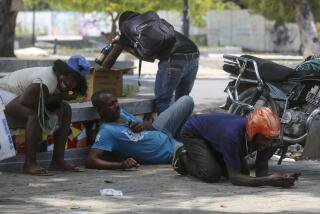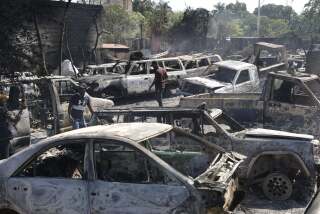Piles of the dead finally buried in Titanyen, Haiti’s ‘valley of death’
On the seaside hills of Titanyen, where Haiti’s dictators discarded the bodies of political opponents, the dead have been dumped by the thousands among the thorn bushes, piled in towers of russet-colored soil and debris.
Shocked by television footage of the site, Port-au-Prince businessman Daniel Rouzier hired two backhoes over the weekend to dig three long, deep rectangular ditches. Growling and beeping, they scooped up 2,500 earthquake victims and buried them in communal graves.
“You have to understand that it’s completely un-Haitian to dump bodies like this,” Rouzier said as he watched, a white mask covering his face. “We have extreme respect for the dead. And these people deserve a decent burial.”
The Jan. 12 earthquake killed an estimated 150,000, about 1 in 13 residents of the Port-au-Prince area. Since then, the capital has hummed with determined international efforts to attend to the living with food, water, shelter and medical care.
But handling the massive numbers of dead has at times overwhelmed the government. Many bodies remain trapped in collapsed homes, businesses, schools and even a fancy shopping mall. And, three weeks later, the choking smell of decomposition still hangs in the air.
Family members of victims continue to chip away at collapsed homes, slowly retrieving the dead for private burial. But at many locations, including government buildings, stores and schools, the bodies are retrieved, along with debris, by government bulldozers.
Last week, several thousand bodies were trucked, often at night, to Titanyen and dumped in the vast public cemetery.
“We didn’t know what to do, there were just so many,” said Oman Oberilise, 26, who works as a gravedigger at Titanyen, about 20 miles north of the capital. Some of the gravediggers, seeing so many bodies, “were afraid that they were still alive,” he added.
Rouzier, local chairman of the charity Food for the Poor, heard about the bodies piling up at Titanyen, called a local Roman Catholic priest, hired the backhoes and enlisted volunteers to go to the site.
As the bulldozers worked, one of the volunteers, 73-year-old Hilaire Polycarpe, brushed white paint on a cross, one of three that was later placed atop the mass graves. He had bought the paint himself that morning.
“I just thought it was important that people know where the bodies are buried,” Polycarpe said.
No one knows the names of those buried here. But, Rouzier said, “the point is to make spiritual peace with what’s happened. And burying people is step one.”
After the burial, the priest offered prayers for the dead and Rouzier placed holy water on the soil.
“Now is not the time to point fingers,” Rouzier said. “Now is the time to make things right.”
Since the quake, more than 10,000 bodies have been buried in Titanyen and another nearby cemetery, where bodies from the Port-au-Prince morgue have been taken to be interred in mass graves.
The cemeteries occupy a rocky landscape above National Route 1, overlooking the water. Titanyen, known locally as the “valley of death,” has a central place in the collective psyche of Haiti. During the dictatorships of Francois Duvalier and his son, Jean-Claude, the bodies of thousands of political prisoners and executed government opponents were dumped there. Even today, it is scattered with skulls from that era.
The death toll from the earthquake has been so massive that, for most, the rituals once followed after a death have gone by the wayside. For those able to recover and identify family members, funerals and burials have been swift.
The pressure to find places to bury the dead is evident in small cemeteries in Port-au-Prince. One burial ground in the Delmas area last week was strewn with coffins that had been dug up and opened, and the bones of the original occupants removed so that earthquake victims could be interred.
Still, as the days pass, the capital’s survivors are, to a remarkable degree, focusing on the future. Even with all the challenges of daily life in a community devastated by loss, they walk the streets in freshly washed clothes. Many men headed to church on Sunday were wearing ties. And street-side car wash businesses were busy, washing the white dust off vehicles.
“People have this impression of Haitians being in a constant state of upheaval and violence,” U.S. Ambassador Kenneth Merten said in an interview. “But 90% of the people living in Port-au-Prince have been handling a very difficult situation in a stoic and dignified fashion.”
By Sunday, the bodies at Titanyen were underground, the freshly turned soil marked with the crosses that Polycarpe had painted.
“We hurt all the way to the bone to see these people dying,” said Oberilise, the gravedigger. “But we have to bury them.”
More to Read
Start your day right
Sign up for Essential California for news, features and recommendations from the L.A. Times and beyond in your inbox six days a week.
You may occasionally receive promotional content from the Los Angeles Times.







